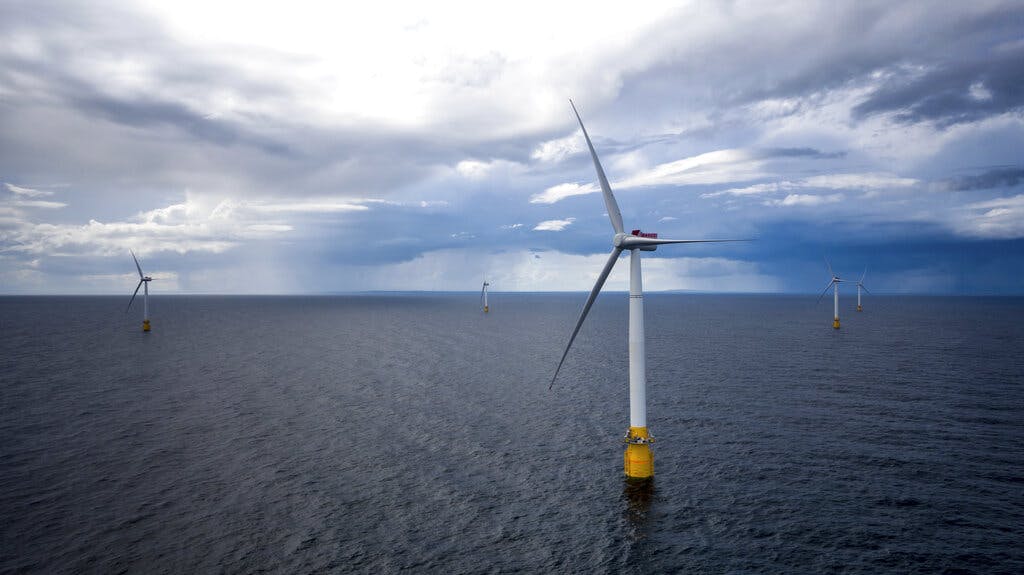Offshore Wind Farms in New England Create Headaches for Both Man and Beast
With more than 27 offshore wind energy projects in development in the Northeast, and more in the planning stages, environmentalists say the ‘industrialization of the ocean’ is a fait accompli.

The Biden administration’s implacable push to achieve 30 gigawatts of wind power by 2030 is threatening the livelihood of thousands of mariners, not to mention the very ecosystem that environmental activists say they wish to protect, commercial fishermen and ocean conservationists tell the Sun.
“I don’t think ever in history has there been such a massive alteration of the ecosystem in such a short amount of time,” says the executive director of New Jersey-based Clean Ocean Action, Cindy Zipf. “We’re looking at 3,500 turbines as tall as the Chrysler Building, 2.2 million acres of ocean, and 10,000 miles of cable just in the Northeast in just the next seven years.”
At the center of the conflict is the North Atlantic right whale and other endangered marine mammals that the Commerce Department’s National Oceanic and Atmospheric Association National Marine Fisheries Service are charged with protecting. Fewer than 350 right whales are left in the Atlantic Ocean, according to the fisheries service.
The fisheries service blames a decline in the whale population on vessel strikes and entanglements with commercial fishing nets. In 2017, it documented a spike in deaths and warned that the population could be wiped out without extensive efforts to save the whales.
In response to its own warning, it issued regulations in 2021 ordering Northeast America’s lobster industry to reduce its risk of “takes” — the injury or disturbances to marine mammals caused by fishing, shipping, and other ocean-faring ventures — by 98 percent over the next decade.
Commercial fishermen say that risk reduction target, which will require lobstermen to use expensive, new, and unreliable trawling gear to avoid entanglements, is based on flawed assumptions. The rules, they say, will put the lobstermen out of business.
“It shouldn’t be a decision between you lose your ability to make an income completely, or to basically price most people out of the fishery so that only two or three survive,” says the executive director of the Long Island Commercial Fishermen’s Association, Bonnie Brady.
Ms. Brady notes that the $1.5 billion lobster industry is the main economic driver in many seaboard towns from Maine to Long Island in New York. Without it, “there aren’t a whole lot of avenues [for these towns] to be going into.”
Fishing associations say a more realistic explanation for the whales’ recent travails is the wind farms going up across the Northeast Atlantic. The survey ships that scout the seas for the projects are five to six times the size of lobster boats.
“2004 was the last known entanglement” of a right whale in an American lobster net, Ms. Brady says. “Looking at it from my pedestrian perspective, what was the one thing that changed? Survey ships started in 2016.”
She suggested that the fisheries service require offshore wind developers to report whale sightings, and that necropsy reports, which are rare, include damage to whales’ eardrums affecting their ability to navigate and find food caused by the pounding construction.
That may not be so easy. Whale counts are managed by the fisheries service. Offshore wind development is managed by the Bureau of Ocean Energy Management, an agency within the Department of Interior that oversees permitting and leasing auctions for the $32 billion industry. That industry is expected to grow to $57 billion by 2026, thanks in part to a 30 percent tax credit created as part of President Biden’s Inflation Reduction Act.
“It’s not in the developers’ interest to have data in advance” about the industry’s impact on whales, said Ms. Zipf. “Without data, they can point the finger at climate change.”
Clean Ocean Action, an environmental group, is tracking dozens of offshore wind projects from Montauk to Cape May. Among those is Ocean Wind 1, a massive 98-turbine wind farm located off the New Jersey coast. The developers, Denmark-based energy company Ørsted, and Newark-based utility Public Service Electric & Gas Co., have requested permission to cause “incidental” injury and disturbances to marine mammals.
The fisheries service told the Sun that it may allow “unintentional take” if it has a negligible impact on the species or its stocks. Proposed regulations for Ocean Wind 1 include measures to avoid and minimize that outcome. “No mortality or serious injury is expected or proposed to be authorized,” the agency said in an email.
However, in a May letter, the fisheries service warned the ocean energy bureau that right whales face considerable threats from offshore wind development.
“Additional noise, vessel traffic, and habitat modifications due to offshore wind development will likely cause added stress that could result in additional population consequences,” wrote the service’s Chief of Protected Species, Sean A. Hayes.
With more than 27 offshore wind energy projects in various stages of development in the Northeast, and more leases in the planning stages, Ms. Zipf says the “industrialization of the ocean” is a fait accompli that ignores broader, long-term effects from offshore wind development.
“We’re not just talking about the ocean ecosystem … but the cavalier attitude of ‘We’ve got to do this,’” she says. “The consequences to the ocean are really not being carefully weighed and evaluated.”
For Ms. Brady, the existential threat is as great to marine mammals as it is to the lobstermen’s way of life. “Some people would like to think the only way is to regulate or strangle fishermen. There’s another way,” she said.

